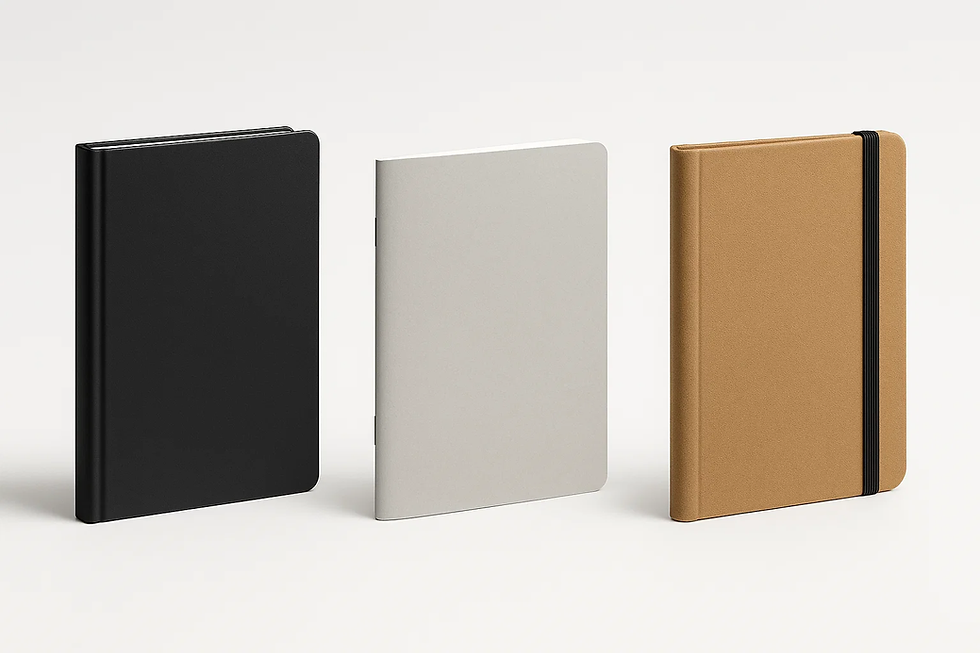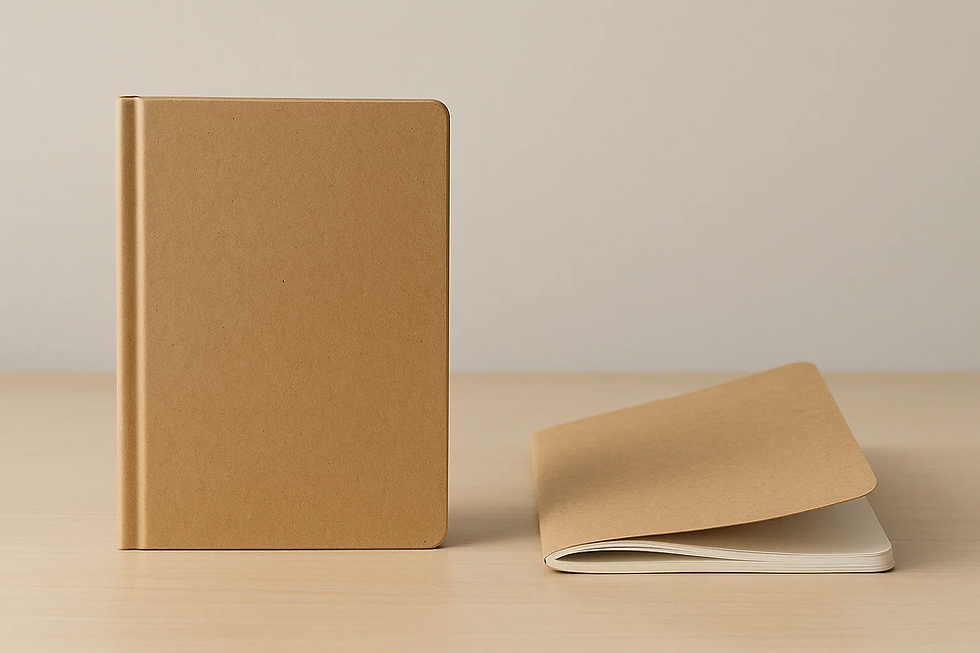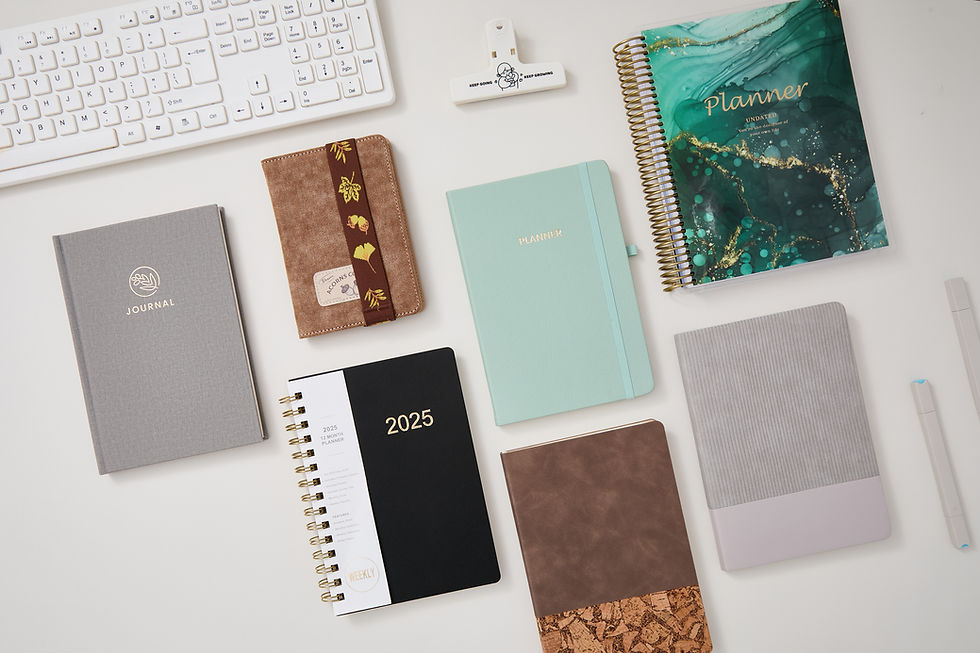Exploring Notebook Covers: Materials and Styles Guide
- Leo Xia

- Aug 20
- 12 min read
Quick Content Reach:
Introduction – Why Notebook Covers Matter
If you sell notebooks, journals or planners in bulk, the cover isn’t just a protective shell – it’s a statement of quality, functionality and brand identity. Notebook covers influence durability, how the book feels in the hand and even whether a buyer associates your brand with professionalism or creativity. When your business relies on repeat customers and lasting impressions, investing time into choosing the right cover materials and styles can enhance product value and customer loyalty. Because our team at Lion Paper Products has over 10 years of experience serving retailers and wholesalers across the United States, Europe, the Middle East and Africa, we understand the nuances of notebook covers intimately. In this article I’ll explore the major cover materials, styles and binding options, share evidence‑backed pros and cons, and explain how each choice fits different markets.

The Role of Notebook Covers in B2B Stationery
Notebook covers serve three essential roles: protection, presentation and branding. A rigid hardcover protects pages from damage during shipping or use and conveys permanence and quality blog.bookbaby.com. Softer covers lower cost and make products lightweight and portable, appealing to students and mass‑market retailers blog.bookbaby.com. Beyond function, cover materials and finishes create visual and tactile cues that communicate your brand’s values. A leather cover exudes sophistication while a canvas cover suggests creativity or eco‑consciousness brprinting.net. For B2B buyers, choosing the right cover can influence margins, shipping costs and customer satisfaction. Throughout this guide I’ll highlight evidence‑based advantages and disadvantages of each material and binding style, so you can make informed sourcing decisions.

Paper Covers – Hard vs Soft for Cost and Durability
Paper covers remain the workhorse of the notebook industry because of their versatility and affordability. They can be broken into two categories: hardcovers and softcovers.
Hardcovers: premium feel and long life
Hardcover notebooks use rigid cardboard 2.5–3.5 mm thick covered with paper, cloth or even leather blog.bookbaby.com. This construction gives them a solid feel and protects the pages from bending and moisture. Industry guides note that hardcovers can withstand wear and tear and are ideal for keepsakes, textbooks and products intended for heavy use printivity.com. The durability justifies a higher price and buyers often perceive them as premium goods blog.bookbaby.com. As a B2B buyer, you might specify hardcovers for planners or executive journals where longevity and professional appearance are paramount. Be aware that hardcovers cost more to produce and ship blog.bookbaby.comblog.bookbaby.com. Case‑laminated covers print artwork directly onto thick cardstock and seal it with a laminate film, offering durability at a lower price pointprintivity.com.
Softcovers: flexible and budget‑friendly
Softcover notebooks (paperbacks) have pliable covers made from heavy paper stock or thin cardboard and are bound with glue blog.bookbaby.com. Their light weight makes them ideal for mass‑market products and promotional giveaways – they’re cheaper to produce and easier to ship blog.bookbaby.comblog.bookbaby.com. Retailers often stock softcovers in supermarkets and convenience stores because the low wholesale price encourages impulse buys blog.bookbaby.com. However, the trade‑off is durability: the covers can crease or tear with heavy use blog.bookbaby.com. Softcovers suit notebooks intended for short‑term projects, school use or disposable notepads.

Considerations for paper covers
When choosing between hard and soft paper covers, evaluate your target customer’s expectations, the intended lifespan of the notebook and shipping logistics. Hardcovers may attract corporate buyers or gift stores seeking premium items, while softcovers provide economical solutions for back‑to‑school campaigns. Additionally, ask about coatings such as matte or gloss lamination – these enhance water resistance and add perceived value.
Lion Paper Products offers both standard and custom paper covers, and we can help you optimize thickness, lamination and design to align with your brand. Reach out via our website to discuss your next project.
Leather Covers – Classic Elegance and Durability
Leather has long been associated with quality and prestige in the stationery world. There are two main types of leather covers: genuine leather and synthetic (PU) leather.
Genuine leather: longevity and patina
A well‑crafted genuine leather cover can last for many years, even decades brprinting.net. Leather’s durability makes it a cost‑effective investment over the life of multiple notebooks, particularly for corporate clients who reuse covers with replaceable inserts. The material develops a natural patina that enhances its unique character over time brprinting.net, giving each notebook a personalized, vintage feel. Leather also exudes a timeless and professional appearance that appeals to executives, luxury brands and gift buyers brprinting.net. However, genuine leather is more expensive and heavier than other options qlstationery.com, and it requires maintenance to prevent cracking brprinting.net. Ethical considerations around animal welfare and environmental impact may also influence your decision brprinting.net.
Synthetic (PU) leather: affordability and versatility
Synthetic leather, including PU (polyurethane) and “leather paper,” offers many of the aesthetic qualities of genuine leather at a lower price point. It can be produced in numerous colors and textures, and it’s often waterproof and scratch‑resistant. According to QL Stationery’s guide, both genuine and synthetic leather covers provide high durability and an elegant touch qlstationery.com. Synthetic leather is lighter and requires less maintenance than natural leather, making it suitable for everyday notebooks and planners. However, synthetic materials may not develop the same rich patina as natural leather and may peel or crack over time. Buyers concerned about animal welfare may prefer PU leather, while those prioritizing longevity might still choose genuine leather.
Vegan and plant‑based leathers
The rising demand for ethical products has spurred innovation in vegan leather made from cork, apple peels or recycled plastics. Paperdec’s sustainability guide notes that vegan leather covers are cruelty‑free and often more sustainable than traditional leather, which has a significant environmental footprint paperdec.com. These materials deliver durability and style while aligning with eco‑conscious consumer values. They are an excellent choice for brands looking to differentiate through sustainable storytelling.

If you want to explore cork, apple or cactus leather for your next notebook line, our R&D team can prototype samples quickly. Reach out and let’s co‑create a product that reflects your commitment to the planet.
Fabric Covers – Soft Textures and Customization
Fabric covers bridge the gap between the luxury of leather and the affordability of paper. They’re popular among fashion‑conscious consumers and brands seeking unique textures and patterns.
Materials and aesthetics
Common fabrics used in notebook covers include canvas, linen, cotton and silk qlstationery.com. These materials offer rich visual effects with customizable colors, textures and prints qlstationery.com. Fabric covers can convey warmth, creativity or nostalgia depending on the weave and design. Because they’re lightweight, fabric‑bound notebooks are easy to carry qlstationery.com. Fabric also pairs well with embroidered logos or screen‑printed artwork, allowing buyers to create distinctive brand pieces
Pros and cons
The advantages of fabric covers lie in their aesthetic flexibility and comfort. They are generally more affordable than leather and even some high‑quality plastics brprinting.net, making them attractive for mid‑tier product lines. Fabric covers are lightweight and portable brprinting.net, which adds convenience for users. However, they are less durable than leather or plastic; fabric can fray, tear or show wear over time brprinting.net. Spills and dirt may stain the fabric, and most textiles provide limited water resistance brprinting.net. When evaluating fabric covers, consider adding a protective coating or lamination. We offer water‑repellent treatments and can help you select weaves that balance aesthetics with durability.

Plastic Covers – Practicality and Waterproofing
Plastic covers are the pragmatic choice for notebooks intended for heavy use, classrooms or field work. They’re typically made from PVC or polypropylene and come in clear or opaque finishes.
Strengths: affordability, water resistance and easy cleaning
Plastic covers are inexpensive and suitable for mass production qlstationery.com. They’re waterproof, stain‑resistant and easy to clean, making them ideal for students and office settings qlstationery.com. The transparent design can showcase a printed insert or allow users to personalise the front page qlstationery.com. BR Printing notes that plastic covers are very affordable, water‑resistant and easy to wipe clean brprinting.net. For B2B buyers, these attributes translate into low unit costs and minimal maintenance – excellent for promotional notebooks, school supplies or industrial contexts.

Limitations: environmental impact and premium perception
The major drawback of plastic is its environmental impact: PVC and many plastics are non‑biodegradable and contribute to pollution brprinting.net. Plastic covers can feel less premium compared to leather or high‑quality fabric brprinting.net, which may not align with brands aiming for a luxury image. Over time, plastic may become brittle and crack, especially under extreme temperatures or prolonged use brprinting.net. If environmental responsibility or long‑term durability is a priority, consider alternatives like vegan leather or recycled PET plastics. Our team can guide you toward eco‑friendly polymers or hybrid covers that balance sustainability with cost. Reach out to discuss your sustainability goals.
Eco‑Friendly Covers – Sustainable Innovation
Sustainability is no longer a niche demand; many buyers and end users seek environmentally friendly products that reduce waste and support ethical practices. Eco‑friendly notebook covers use materials and processes designed to minimise environmental impact.
Eco‑friendly notebooks often employ recycled or tree‑free paper. Recycled paper is made from post‑consumer waste and reduces the demand for virgin fiber, saving energy and lowering waste paperdec.com. Tree‑free papers made from bamboo, sugarcane or hemp grow quickly and require less water and fewer chemicals than traditional trees paperdec.com. Stone paper, made from calcium carbonate and resin, is water‑resistant and tear‑resistant paperdec.com. Vegan leather made from cork, apple peels or recycled plastic offers a cruelty‑free alternative to animal leather while still delivering durability and style paperdec.com. Plantable covers embedded with seeds allow the notebook to be planted after use, turning waste into plants paperdec.com. Each material carries its own tactile quality and story – a powerful marketing tool for sustainable brands.
Responsible manufacturing and certifications
Sustainability isn’t just about materials; processes matter too. Eco‑friendly manufacturers often reduce water and energy consumption and minimise waste through recycling and efficient production methods paperdec.com. Ethical labour practices, including fair wages and safe working conditions, are another pillar of responsible manufacturing paperdec.com. When sourcing sustainable notebooks, look for certification like FSC (Forest Stewardship Council), and recycled content certifications paperdec.com. These labels verify that materials come from responsibly managed forests or recycled sources.
Lion Paper Products holds ISO9001, FAMA, California Proposition 65, CPSIA and other certifications; we also partner with factories certified under BSCI and SMETA to ensure ethical production. We can help your brand align with sustainability goals while meeting regulatory requirements – just ask.
Business benefits of sustainable covers
Choosing eco‑friendly covers can reduce your products’ carbon footprint and appeal to consumers who value environmental responsibility. Paperdec notes that notebooks made from recycled or alternative materials help reduce deforestation and biodiversity loss paperdec.com. Supporting sustainable suppliers encourages positive social and environmental change paperdec.com. Modern eco notebooks are also stylish and high‑quality, offering vibrant colours and smooth paper without compromising performance paperdec.com. By integrating sustainability into your product line, you differentiate your brand, attract new customers and potentially command a premium price.

Protective Sleeves and Dust Jackets
Beyond the primary cover, you can offer protective sleeves or dust jackets to enhance durability and extend a notebook’s life. Cover sleeves are thin plastic or paper jackets that shield the cover from dust, stains and wear qlstationery.com. Their advantage is that they provide extra protection during storage and transport qlstationery.com, making them suitable for collectors’ editions or premium planners. On the downside, sleeves may need replacement, and frequent removal can wear the underlying cover qlstationery.com. Dust jackets are common on hardcover books; they protect the spine and outer surface while allowing additional artwork or promotional information printivity.com. For B2B buyers, offering sleeves or jackets can be an upsell that protects inventory during shipping and appeals to customers who value pristine products. Talk to us about custom‑printed sleeves, including window cut‑outs or foil details, to add value to your next notebook launch.
Cover material is only part of the story; the binding style influences how a notebook opens, how it’s used and how long it lasts. Understanding these options helps you match products to specific audiences.
Spiral and wire‑O bindings
Spiral and wire‑O notebooks use plastic or metal coils inserted through punched holes to bind the pages printivity.com. They allow pages to lie flat or fold back completely, which improves usability for reference books, cookbooks or field notebooks. These bindings can accommodate thick pages and high page counts printivity.com. Plastic spirals are lightweight and inexpensive, while metal wire‑O bindings offer a sleek appearance and greater durability. When paired with a sturdy cover, coil‑bound notebooks are ideal for catalogs, manuals and planners.
Perfect binding and PUR binding
Perfect binding glues folded pages into a squared spine, creating a clean, book‑like appearance. Printivity notes that perfect binding is cost‑effective, lightweight and customizable printivity.com. It’s often used for magazines, catalogs and business presentations. PUR binding uses polyurethane reactive glue that forms a stronger bond than traditional EVA adhesives printivity.com. PUR‑bound notebooks withstand heavy use and are suitable for manuals, textbooks or guides that need to last years. Both methods work best with soft covers or case‑laminated hardcovers.
Case‑laminated and case‑bound options
Case‑laminated covers print artwork directly onto thick cardstock, then seal it with a laminate film before attaching it to the book block printivity.com. This technique combines the sturdiness of a hard cover with the flexibility of full‑colour printing, making it budget‑friendly and durable. Traditional case‑bound hardcovers attach the cover to the book block with endpapers and often include dust jackets for extra protection printivity.com. Both styles project quality and are ideal for high‑end journals, commemorative books or corporate gifts. If you want the luxurious feel of a hardcover without the cost of separate dust jackets, consider case‑laminated binding. Our production lines include automatic laminating and stamping machines that ensure crisp edges and vibrant colours. Learn more.

How to Choose the Right Cover for Your Market
Selecting the right cover involves balancing durability, cost, aesthetic, sustainability and brand positioning. Here are some factors to consider:
Target user and use case – For corporate gifts or executive planners, choose durable materials like genuine leather or case‑bound hardcovers. For students or promotional giveaways, softcovers or plastic may suffice. Fabric covers suit lifestyle brands seeking texture and uniqueness.
Budget and margins – Hardcovers and genuine leather cost more but can command higher retail prices blog.bookbaby.com. Softcovers and plastic covers are economical and ideal for high‑volume orders blog.bookbaby.com. Evaluate total cost of ownership, including shipping and potential replacements.
Environmental commitments – Eco‑friendly covers made from recycled or alternative materials appeal to a growing segment of eco‑conscious consumers paperdec.com. Certifications such as FSC and Blue Angel signal responsible sourcing paperdec.com. Vegan leather and plantable covers can differentiate your brand paperdec.compaperdec.com.
Brand identity – Consider how the material aligns with your brand’s story. Leather and case‑bound covers convey premium quality and tradition. Fabric offers warmth and individuality. Minimalist recycled paper or stone covers highlight sustainability.
Functional requirements – If your notebooks need to lie flat or accommodate many pages, coil or wire‑O binding may be necessary printivity.com. For field use or harsh environments, water‑resistant plastic or stone paper covers make sense brprinting.netpaperdec.com.

Decisions can be complex, especially when purchasing in bulk for diverse markets. At Lion Paper Products we offer consultation, prototyping and manufacturing expertise. We invest in high‑end equipment and skilled craftspeople to ensure every notebook meets strict quality standards. Contact us via our website or WhatsApp to discuss your needs and receive tailored recommendations.
Conclusion
Notebook covers do far more than hide pages; they communicate value, protect content and express brand personality. By understanding the strengths and limitations of paper, leather, fabric, plastic and eco‑friendly materials—and pairing them with appropriate binding styles—you can offer products that resonate with your customers and support your brand goals. As you plan your next product line, remember that our team at Lion Paper Products is ready to help you navigate these choices.
—Leo Xia, CEO, Lion Paper Products
You design, we deliver.
FAQs:
Q1: What are the main differences between hardcover and softcover notebooks?
A: Hardcovers use thick rigid boards covered with paper or cloth, offering durability and a premium look. Softcovers use flexible paper stock and glue, making them lighter and cheaper.
Q2: Are fabric notebook covers durable?
A: Fabric covers offer rich textures and are lightweight, but they’re less durable than leather or plastic and can fray or stain.
Q3: What makes a notebook cover eco‑friendly?
A: Eco‑friendly covers use recycled paper or alternative fibers like bamboo and hemp , are produced with reduced water and energy use, and may carry certifications such as FSC or Blue Angel.
Q4: How do spiral and wire‑O bindings differ?
A: Both allow notebooks to lie flat and turn pages easily. Spiral bindings use a continuous plastic or metal coil, while wire‑O uses paired metal loops for a more professional finish.
Q5: What is case‑laminated binding?
A: Case‑laminated covers print artwork directly onto thick cardstock and seal it with a laminate film, providing durability and full‑colour customization at a lower cost than separate dust jackets.
Q6: Why should businesses consider eco‑friendly notebooks?
A: Choosing sustainable materials reduces deforestation and supports ethical suppliers. Eco notebooks can attract environmentally conscious customers and strengthen a brand’s social responsibility image.
Are you looking for a reliable manufacturer? Reach out to Lion Paper for a free quote and consultation. Let’s collaborate on creating custom writing paper products that will set your brand apart from the competition!





Comments